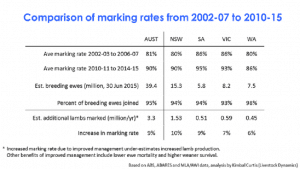
Dr Jason Trompf
AUSTRALIA’S sheep producers have lifted lamb marking rates by up to 10 percent in less than 10 years, helped by flock structure changes, improved pre and post-lambing ewe nutrition and post-lambing management.
At the Animal Production 2016 conference in Adelaide yesterday, consultant Dr Jason Trompf said the latest lamb marking data showed the national average lamb marking rate of 81pc between 2002/3-2006/7 has been increased to 90pc in 2010/11-2014/15 period, with the biggest improvements in the eastern states.
The average lamb marking rate has lifted by 6pc to 86pc in Western Australia, by 7pc to 93pc in Victoria, by 9pc to 95pc in South Australia and by 10pc to 90pc in New South Wales. The statistics are based on ABS, ABARES and MLA/AWI survey data, compiled and analysed by Kimbal Curtis (Livestock Dynamics, WA).
Dr Trompf said lamb survival is getting increasing attention as an opportunity for producers to improve both production and welfare outcomes, and flock owners had a responsibility to deliver a premium product with transparency and accountability that warranted ongoing investment by consumers.
“We can actually have our cake and eat it as well.”
“Once in a lifetime an opportunity comes along where you have a set of practices that can drive productivity, profit and welfare outcomes simultaneously.
“You’ve got an industry that is striving for per hectare and per head performance as its aim – not one without the other, and you’ve also got an industry that wants to feed and clothe the masses with a consistent supply of meat and wool but at the same time sustain a breeding flock.
“And right at the heart of that is lamb survival.”
Improving on 2005 lamb loss of $700 million
Dr Trompf said Australian lamb loss in 2005 was valued at $700 million per annum, when less than 10 per cent of producers knew what their lamb losses were and there was a lack of understanding of the causes of lamb death.
“The same surveys showed that we were losing about 5 pc of breeding ewes per annum.”
This was exacerbated by a focus on wool cut and micron, little attention on ewe resilience, highly variable seasons and very few farmers being able to do an energy budget on their breeding ewes,” he said.
“I think it is fair to say that back then we had a flock that was really at a serious intersection.”
Producers also felt that the primary causes of lamb loss were weather and predation and out of their control, but Victorian DPI sentinel flock data showed there was an opportunity for producers to significantly influence lamb survival outcomes on their farms.
Recent changes included a reduction in the percentage of Merino ewes in the Australian flock from 85pc as recently as 2008 to now about 70pc and an increase in the market value of lambs.
“So suddenly we are saying that in the last 10 years when we’ve spent a lot more time in the $5-$6 a kilogram (lamb value) bracket and that every lamb she has is worth gold, but the really exciting story is where we’ve gone to reproduction-wise,” Dr Trompf said.
“We are sitting on a national average of about 92pc lambs marked (in 2014-15).”
Non-Merino ewes help reproductive progress
 Dr Trompf said he wanted to be “proud of the progress made” in relation to the sheep industry’s reproductive achievement, but also wanted to be sincere about the challenge to continue to progress.
Dr Trompf said he wanted to be “proud of the progress made” in relation to the sheep industry’s reproductive achievement, but also wanted to be sincere about the challenge to continue to progress.
“Because guess what, to continue to sustain our supply of markets the Sheep Industry Strategic Plan just put out wants a continued gain of 1pc marking gain per annum to 2020.”
Dr Trompf said a doubling of the number of non-Merino ewes in the Australian flock accounts for about a third of the increase in the national marking rate, arising from a doubling of the number of Merino ewes joined to non-Merino sires in 2009-10.
But he said for the past 10 years there had been a serious industry campaign and investment to improve flock reproduction efficiency, including the Lifetime Ewe Management program, with over 3000 participants with 10 million ewes (25pc of the national flock) lifting stocking rates by 1DSE/Ha, and improving lamb weaning rates by 96pc to 105pc and ewe mortality from 4.1pc to 2.9pc. Other projects have also contributed to these gains, including Ewe Time Forums, Making More From Sheep and Bred Well Fed Well.
He said three key practices that are “absolute musts” for the Australian sheep producer in maximising lamb and ewe survival are pregnancy scanning to identify and target management of ewes carrying multiple lambs, ewe condition scoring to allocate feed based on energy requirements and feed budgeting.
Have your cake and eat it
Dr Trompf said LTEM had delivered stocking rate and marking rate increases of 10pc while cutting ewe mortality by 30pc.
“You can have your cake and eat it as well.”
Post-LTEM practice changes include more producers assessing pasture quality and quantity, condition scoring ewes, scanning ewes for multiples and managing separately to single-bearing ewes, calculating ewe energy budgets and quantifying lamb survival rates.
In a WA benchmarking group of 80 producers, run by ICON Ag and Agrarian, more than half of which are LTEM graduates, 80pc of the difference between the high profit Merino farms and the average is tied up in their livestock trading profit.
“What do you know it’s a similar story to LTEM, a 7pc higher stocking rates, 9pc higher lamb weaning percentage and a 10pc higher sale price for sheep and lambs.
“No longer is the story, ‘put them on as thick as you can stick at a low cost of production and have the ewe and lamb struggle’ – that’s not a complete story and it is not where the Australian sheep industry is proudly at any more, we’ve graduated well beyond that.”
Dr Trompf said about 30pc of Australia’s breeding ewes are now pregnancy scanned for multiple foetuses, but there was still room for more improvement.
Despite a 15pc reduction in lamb losses nationally in the last 10 years, there was still a long way to go.
Lamb survival is starting to shift nationally which is tremendous, but with more on-farm practice change there was scope to reduce lamb losses by about 50pc, he said.
Lamb survival comparable to overseas shedded results
Dr Trompf said best practice lamb survival outcomes among Merino and crossbred flocks compares favourably to results in overseas shedded flocks.
“A 10pc overall lamb loss is achievable and a tremendous effort in an extensive environment and we remain resolute in the pursuit of trying to reduce that.”
Dr Trompf said Lifetime Wool Research indicated 70pc of a lamb’s likelihood for survival is governed by its birth weight, with the critical birth weight being about 8pc of the standard reference weight of the ewe.
“Once you come under 8pc (or around 4kg for a 50kg ewe), the risk of death goes through the roof.”
Dr Trompf said LTEM was not a “fat ewe project”, as critics referred to it 10 years ago, but was all about optimal allocation of limited farm resources to the animals that can best respond most.
“Lamb survival is a production hand brake, it is absolutely critical economically, and it also has major social-welfare benefits around it – it’s like a triple whammy.
“What we need to do here is stay the course, evaluate and continuously improve,” he said.
“Forever seeking the new opportunities and finally be genuine and transparent about this journey.
“We must connect and share our story, because if we don’t, others will do that on our behalf and I reckon lamb survival in the Australian sheep industry is one that we can do that around.”



From a look at the paper by Kimbal Curtis, it would seem that the major part of the tiny increase in lamb marking percentage could be explained by the shift to higher micron Merino ewes and non-Merino genotypes.